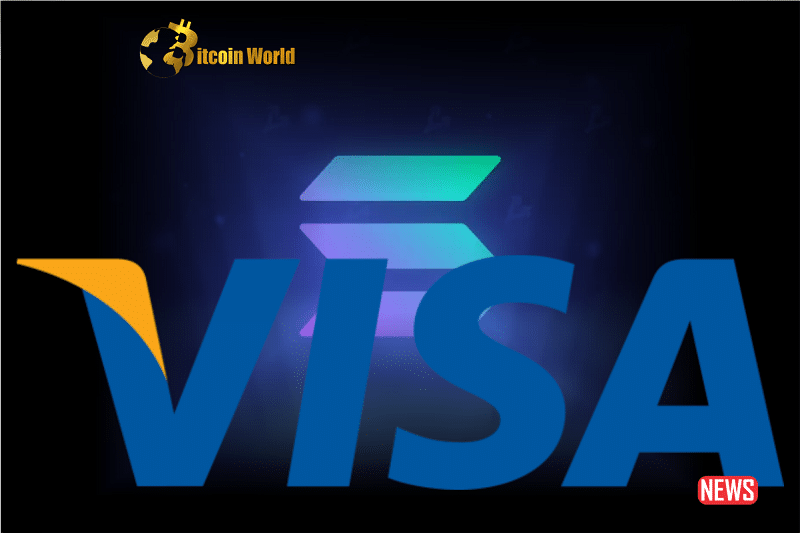Imagine sending money across borders in the blink of an eye, without hefty fees or frustrating delays. That future is rapidly becoming a reality, thanks to a significant move by payments giant Visa. Ready to dive into how Visa is shaking things up in the world of digital payments? Let’s get started!
Visa Embraces Solana for Stablecoin Settlements: What’s the Big Deal?
In a groundbreaking announcement, Visa revealed its expansion into stablecoin settlements on the Solana blockchain. This isn’t just a small step; it’s a significant stride towards modernizing how money moves globally. Visa has successfully completed real-world pilot tests, demonstrating the seamless transfer of millions of USDC stablecoin tokens between the Solana and Ethereum networks. These transactions weren’t just theoretical; they were used to settle actual fiat currency-based payments processed through VisaNet.
Why Solana? The Need for Speed and Efficiency
You might be wondering, why Solana? Cuy Sheffield, Visa’s Head of Crypto, hit the nail on the head: there’s a growing demand for high-performance blockchains that can handle stablecoin transactions with greater speed and at a lower cost. Solana has been making waves with its impressive transaction speeds and reliability, boasting over six months of uninterrupted service and 100% uptime since February. This makes it an ideal partner for Visa’s ambitions in the digital currency space.
Who’s Involved? Key Players in this Payment Revolution
Visa isn’t going it alone. They’ve teamed up with some major players in the payments ecosystem:
- Worldpay and Nuvei: These merchant acquirers are crucial collaborators in this initiative, facilitating the acceptance of these new settlement methods.
- Crypto.com: This isn’t a new partnership. Back in 2021, Visa began exploring the use of USDC in its treasury operations, leading to a successful pilot with Crypto.com.
The Crypto.com Pilot: A Glimpse into the Future
Let’s delve deeper into that Crypto.com pilot. It was a pivotal moment, marking one of the largest payment networks experimenting with stablecoin settlements from the issuer’s perspective. Here’s what happened:
- Visa used USDC and the Ethereum blockchain to collect payments from Crypto.com for cross-border transactions within their active card program in Australia.
- The pilot effectively eliminated the slow and expensive process of currency conversions and international wire transfers for cross-border purchases made with Crypto.com Visa cards.
- The results were so positive that Crypto.com now uses USDC to meet its Visa card settlement obligations in Australia.
Benefits Unveiled: What Does This Mean for Everyone?
This move by Visa unlocks a multitude of benefits. Let’s break them down:
| Benefit | Description |
|---|---|
| Faster Settlements | Transactions are processed much quicker compared to traditional methods, reducing waiting times for businesses. |
| Lower Costs | Eliminating intermediaries and traditional banking fees can significantly reduce transaction costs. |
| Increased Efficiency | Streamlined processes minimize manual intervention and potential errors. |
| Modern Payment Options | Provides clients with a contemporary way to send and receive funds from Visa’s treasury. |
| Enhanced Transparency | Blockchain technology offers a transparent and auditable record of transactions. |
Are There Challenges? Navigating the New Landscape
While the benefits are compelling, it’s important to acknowledge potential challenges:
- Regulatory Uncertainty: The regulatory landscape for stablecoins and blockchain technology is still evolving globally.
- Scalability Concerns: While Solana offers high throughput, ensuring long-term scalability as adoption grows is crucial.
- Security Risks: Maintaining robust security measures to protect against potential vulnerabilities in blockchain networks is paramount.
- Adoption Rate: Widespread adoption by merchants and consumers is essential for the full potential of this technology to be realized.
Visa’s Vision: Leading the Charge in Digital Currency Innovation
Visa’s commitment to exploring and leveraging digital currencies and blockchain technology is clear. This initiative positions them as a frontrunner in the evolving financial landscape. By embracing stablecoins and high-performance blockchains, Visa is actively shaping the future of how we move money.
What’s Next? The Road Ahead for Stablecoin Settlements
Visa’s move is a strong indicator of the growing importance of stablecoins in the global financial system. We can expect to see further developments in this space, including:
- Increased adoption of stablecoin settlements by other major payment processors.
- Further integration of blockchain technology into traditional financial infrastructure.
- Development of new use cases for stablecoins beyond cross-border payments.
- Continued innovation and competition among blockchain networks.
Conclusion: A Transformative Step for Global Payments
Visa’s embrace of Solana for USDC settlements is more than just a news headline; it’s a significant step towards a more efficient, faster, and cost-effective global payment system. By leveraging the power of blockchain technology and stablecoins, Visa is not just adapting to the future of finance – they’re actively building it. This move promises to benefit businesses and consumers alike, paving the way for a truly interconnected and seamless financial world. The integration of Solana into Visa’s settlement process marks a pivotal moment, signaling a new era in digital payments where speed, efficiency, and innovation take center stage.
Disclaimer: The information provided is not trading advice, Bitcoinworld.co.in holds no liability for any investments made based on the information provided on this page. We strongly recommend independent research and/or consultation with a qualified professional before making any investment decisions.


